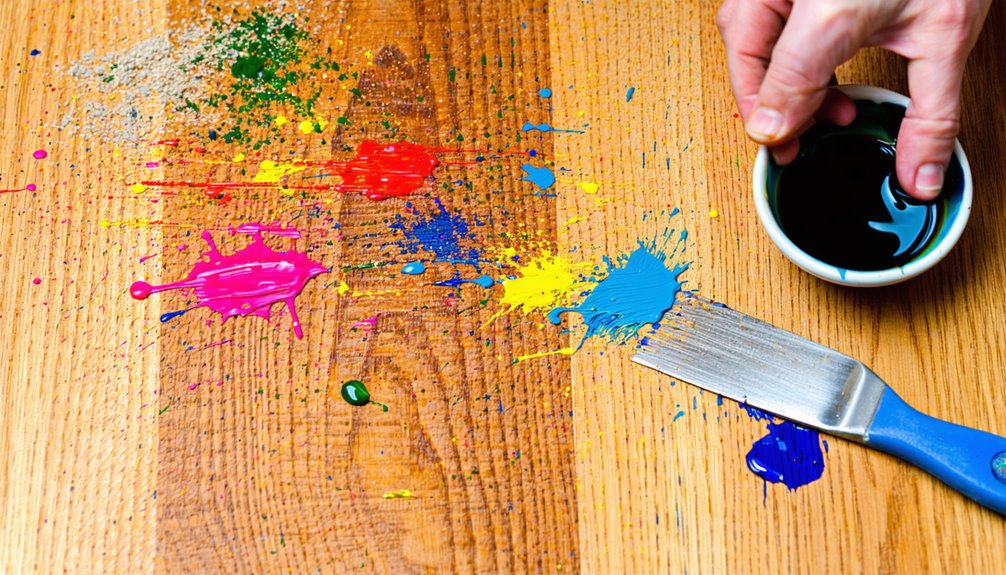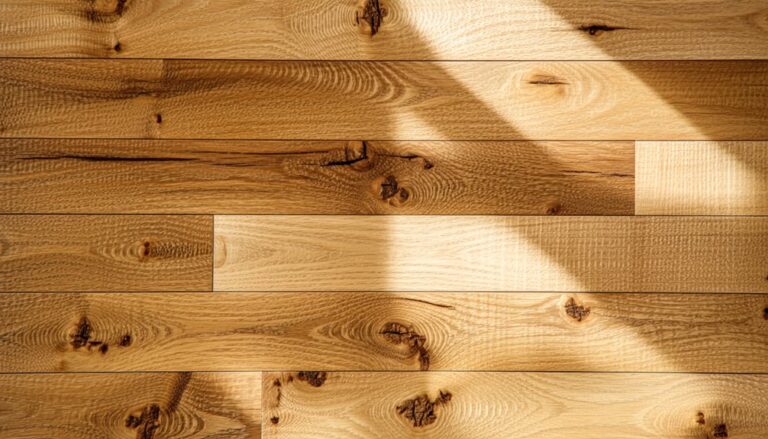To remove paint from wood floors, start by identifying the type of paint. Gather necessary supplies like a paint remover, scraper, soft cloths, gloves, and safety goggles. Test a small area with the remover to verify it's safe for your wood. If the paint resists, you might use a heat gun to soften it, making scraping easier. After scraping, clean the area with mild soap and water, then polish the wood to restore shine. Remember to keep your workspace well-ventilated and protected. There's more to know for a successful paint removal process that can keep your floors looking great.
Assessing the Type of Paint
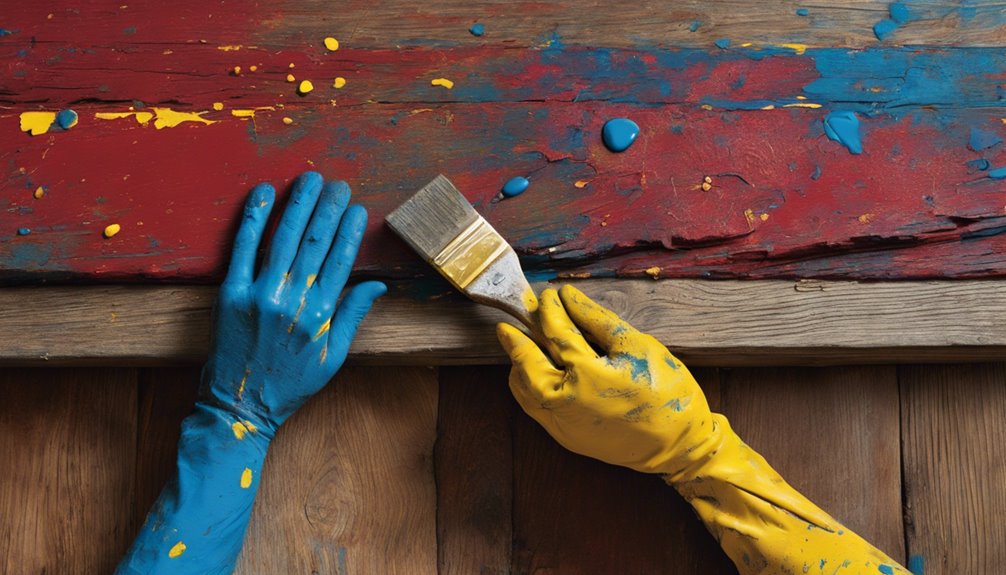
How can you tell what type of paint you're dealing with on your wood floors? Start by inspecting the paint's appearance and feel. If it's glossy, it might be a latex or oil-based paint, while a matte finish often indicates chalk or water-based paint. You can also check for flexibility; latex paints are generally more flexible, whereas oil-based paints tend to be harder. To identify the paint types, dab a small amount of solvent like rubbing alcohol on a hidden area. If it softens, you're dealing with latex. If it doesn't, it's likely oil-based. Knowing the type of paint helps you choose the right method for removal, ensuring your wood finishes remain intact and unharmed during the process.
Gathering Necessary Supplies
Before diving into the paint removal process, it is vital to gather the necessary supplies. Having the right tools on hand will make the task smoother and more efficient. Here's a quick list of essential tools you'll need:
| Tool | Scopo | Quantity |
|---|---|---|
| Putty knife | Scrape off paint | 1 |
| Paint remover | Dissolve paint | 1 bottle |
| Rags or paper towels | Wipe up residue | Several |
| Carta vetrata | Smooth the wood post-removal | 1 pack |
Test a Small Area
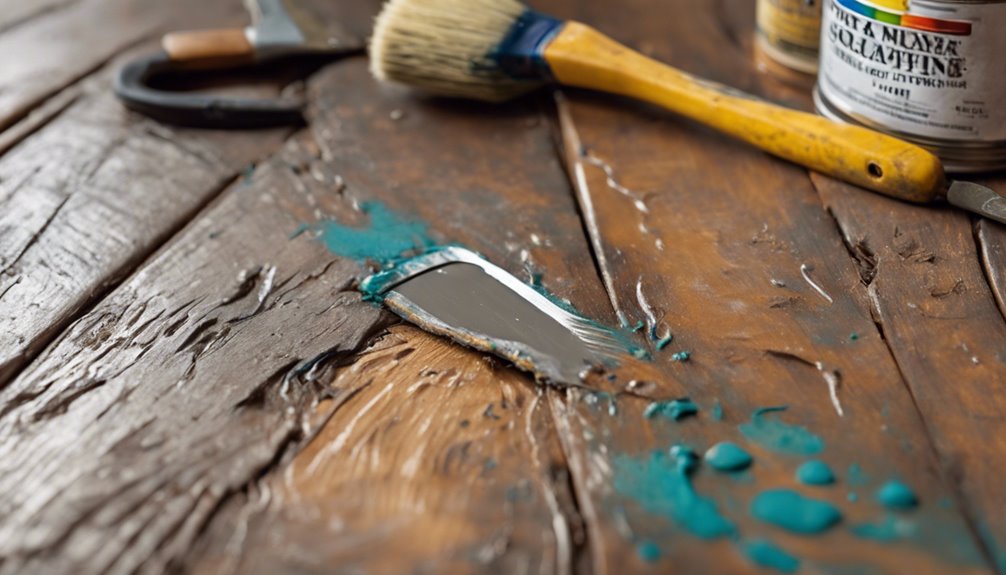
Before you start removing paint, it's important to test a small area first. Choose an inconspicuous spot on your wood floor and apply the paint remover gently to see how the wood reacts. Keep an eye out for any signs of damage, so you can adjust your approach if needed.
Choose an Inconspicuous Spot
When you're ready to tackle paint removal from your wood floors, it's crucial to start in a spot that won't be immediately visible. Choose a test location, like a corner or underneath furniture, to avoid any potential damage to high-traffic areas. This way, you can assess how the paint remover interacts with your pavimentazione without compromising its overall appearance. Before applying anything, make sure you've taken steps for floor protection, like placing a drop cloth to catch any drips. This simple precaution can save you from a bigger mess. By testing in an inconspicuous spot, you'll gain confidence in your approach, making certain your wood floors remain beautiful and intact as you work toward paint removal freedom.
Apply Paint Remover Gently
Now that you've chosen an inconspicuous spot for testing, it's time to apply the paint remover gently. Start by using a soft cloth or sponge to dab the remover onto the paint. Remember, a gentle application is key to preserving your wood floor's beauty. Follow these steps:
- Use a minimal amount of paint remover to avoid saturation.
- Apply it in a circular motion for even coverage.
- Wait a few minutes to let it work its magic.
- Wipe away with a clean cloth to see the results.
This careful approach helps guarantee you maintain your floor's elegance while effectively removing unwanted paint. Enjoy the freedom of a clean floor without compromising its integrity!
Observe for Damage Signs
As you apply the paint remover, it is crucial to observe for any signs of damage in the wood. Start with a small, inconspicuous area. This way, you can assess how the wood reacts without risking extensive damage. Look for damage indicators like discoloration, warping, or splintering during your visual inspection. If you notice any adverse changes, it's a red flag that the remover might be too harsh for your floor's finish. In such cases, consider switching to a gentler product or method. Always prioritize the integrity of your wood floors while seeking that fresh look. Remember, patience is key—taking the time to observe can save you from costly repairs later on.
Using Heat to Remove Paint
Using heat can be an effective way to remove paint from your wood floors, but you'll need the right tools to get started. In this section, you'll learn a step-by-step process and important safety precautions to keep in mind. With the right approach, you can safely and efficiently tackle paint removal.
Tools Needed for Heating
To effectively remove paint from wood floors with heat, you'll need a few essential tools. These tools will empower you to reclaim your beautiful floors and break free from unsightly paint.
- Heat Gun – This powerful tool allows you to direct hot air precisely where you need it, softening the paint for easy removal.
- Infrared Heater – A great alternative for larger areas, this tool emits heat that penetrates deep, loosening paint without damaging the wood.
- Scraper – A sturdy scraper is vital for gently lifting the loosened paint off your floor.
- Protective Gear – Don't forget gloves and goggles to keep yourself safe while working with heat.
With these tools in hand, you're ready to tackle that paint and restore your floors to their former glory!
Step-by-Step Process
Before you plunge into the paint removal process, make sure you've prepared your workspace by clearing the area of furniture and covering nearby surfaces to protect them from heat damage. Start by plugging in your heat gun and adjusting it to a low setting. Direct the heat onto the paint in small sections, keeping the gun moving to avoid scorching the wood. As the paint softens, use a putty knife to gently scrape it off. Repeat this process until all the paint is removed. Remember, patience is key. Afterward, clean the area with a damp cloth to remove any residue. Following these paint removal techniques will help maintain your wood floors while ensuring they look their best. These floor maintenance tips will keep your space beautiful and inviting.
Safety Precautions Required
While the heat method is effective for removing paint from wood floors, safety precautions can't be overlooked. To guarantee your freedom during this process, follow these essential safety measures:
- Wear protective gear, including gloves and safety goggles, to shield yourself from heat and debris.
- Use a heat gun with adjustable settings to maintain control and prevent damage to the wood.
- Ensure proper ventilation measures by opening windows and using fans to disperse fumes and heat.
- Keep a fire extinguisher nearby, just in case things go awry.
Chemical Paint Removers
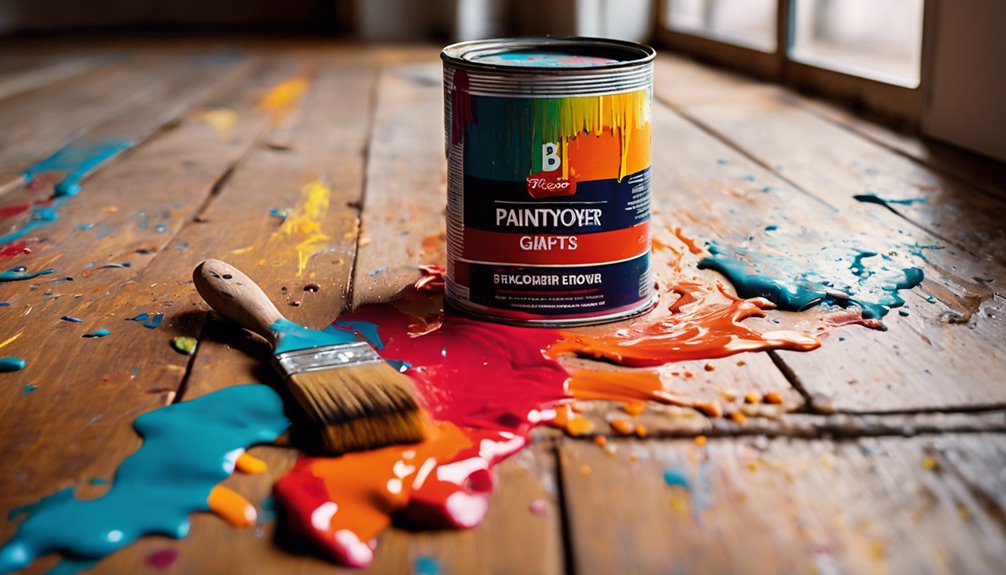
If you're looking for a quick solution to removing paint from wood floors, chemical paint removers can be highly effective. These products work by breaking down the paint's bond with the wood, making it easier to wipe away. When using chemical paint removers, always prioritize chemical safety—wear gloves, goggles, and guarantee good ventilation.
There are eco-friendly options available that reduce harmful fumes and environmental impact, so consider those if you're concerned about toxicity. Always read the label for instructions and safety precautions, as some removers may require specific application techniques. Remember, while chemical removers can save time, it's vital to follow safety guidelines to protect yourself and your home.
Scraping Techniques
When dealing with stubborn paint on wood floors, scraping techniques can be an effective and straightforward approach. Here's how to maximize your efforts:
- Choose the Right Scraper: A metal scraper works best for tough paint.
- Adjust Scraping Angles: Hold the scraper at a low angle for better leverage and efficiency.
- Control Surface Pressure: Apply even pressure to avoid damaging your floor while ensuring you remove the paint effectively.
- Work in Sections: Focus on small areas to maintain control and prevent fatigue.
Cleaning and Finishing Touches
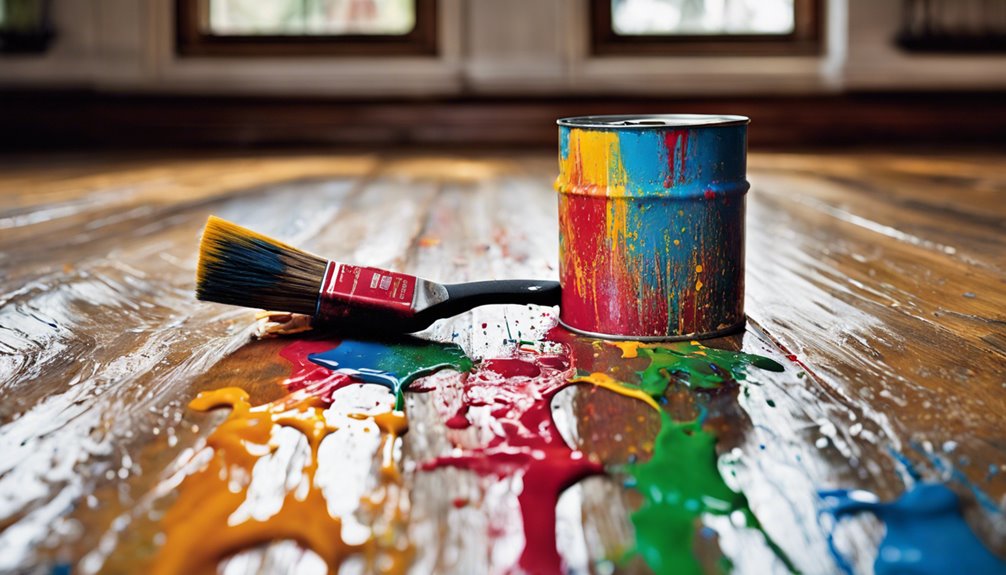
After you've successfully scraped off the paint, it's important to clean the area thoroughly to restore the wood's natural beauty. Use gentle cleaning techniques, like mixing warm water with a few drops of mild dish soap, and wipe the floor with a soft cloth. Avoid harsh chemicals that can damage the wood. Once clean, dry the area with a separate cloth to prevent moisture damage.
Here's a quick reference table for your finishing touches:
| Fare un passo | Azione | Scopo |
|---|---|---|
| Clean | Use mild soap and water | Remove residue |
| Dry | Wipe with a dry cloth | Prevent water damage |
| Polish (Optional) | Apply wood polish | Enhance shine and protection |
These steps will guarantee your floors look great and last longer!
Domande frequenti
Can I Use a Pressure Washer to Remove Paint From Wood Floors?
Did you know that pressure washers can remove up to 90% of surface contaminants? However, using one on wood floors isn't recommended due to the risk of damage. While pressure washer effectiveness is great for tough surfaces, wood floor safety must be your priority. High pressure can splinter or warp the wood, leading to costly repairs. Instead, consider gentler methods to preserve your floors while effectively removing paint.
Is It Safe to Use Vinegar for Paint Removal?
Using vinegar for paint removal can be effective, but you should consider its safety. Vinegar's acidity can help break down paint, making it easier to scrape off. However, it's crucial to test a small area first, as it might damage certain finishes on surfaces. Always guarantee proper ventilation and wear gloves to protect your skin. While vinegar is a natural option, you might want to explore other methods for tougher paint jobs.
How Long Does Paint Removal Typically Take?
When it comes to paint removal, you might think it takes eons, but it usually doesn't! The time estimation for paint removal methods can vary widely, typically ranging from an hour to several hours, depending on the method you choose and the paint's stubbornness. If you're using a chemical remover, it might be quicker, while sanding could take longer. Just be patient, and soon you'll reclaim your beautiful wood!
Will Removing Paint Damage My Wood Floor Finish?
Removing paint can potentially damage your wood floor finish, but it largely depends on the paint removal techniques you choose. If you use gentle methods like a solvent or a heat gun, you're less likely to harm the finish. Always prioritize wood floor care by testing any technique in an inconspicuous area first. With the right approach, you can achieve a clean surface without sacrificing your floor's beauty.
Can I Hire Professionals for Paint Removal?
If you're feeling overwhelmed by paint removal, hiring professionals might be your golden ticket to freedom. Professional services can handle the job efficiently, sparing you the hassle. However, keep in mind that cost factors can vary based on the extent of the work needed, so it's wise to get estimates. Ultimately, choosing experts can save you time and guarantee a clean finish, letting you enjoy your space without the stress of DIY efforts.

